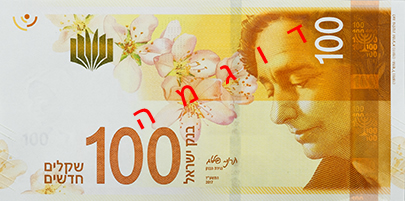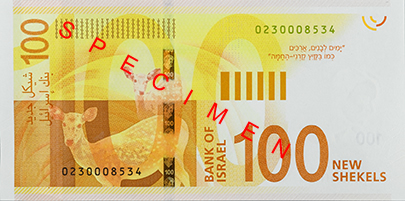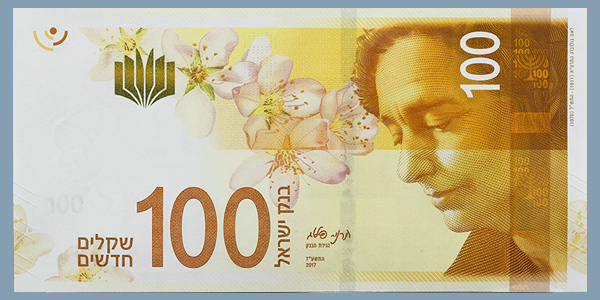The New Banknotes > 100 New Israel Shekels
100 New Israel Shekels
Portrait: Leah Goldberg.
Dominant color: Orange.
Dimensions: 71 x 143 mm.
Obverse layout: A portrait of the poetess against a background of almond blossoms.
Reverse design: A group of does—the inspiration for her poem “What Do the Does Do?”, which is also the name of her first children’s book, and an excerpt from her poem “White Days”.
Features for the blind and vision impaired: Three pairs of lines printed in raised ink, along both the left and right sides of the banknotes, near the bottom.
Date of issue: 2017
Designer: Osnat Eshel.
For information on the security markings visible to the public: Press here
![]() at the banknote
at the banknote
- The transparent portrait- A watermark image of the portrait, identical to the portrait shown on the banknote obverse, with the denomination next to it.
- The perforated numerals – Tiny holes forming the shape of the banknote's denomination are perforated at the top part of the banknote.
- Window thread – A security thread is embedded in the banknote substrate and revealed in three "windows" on the back of the banknote. When tilting the banknote the thread changes its shade from blue to purple.
- Raised ink – The portrait, signature of the Governor, the Hebrew and Gregorian year, texts in three languages, as well as a designated features for the blind on the banknote's margins, are printed in intaglio.
- The glittering stripe – A transparent and glittering stripe next to the portrait. When tilting the banknote, the symbol of a Menorah and the nominal value alternately appear and disappear.
- The golden book – An artistic reflective foil element in the shape of an "open golden book". When the banknote is tilted backward and forward, the book changes its color from gold to green and simultaneously a horizontal line moves up and down across the book.
Leah Goldberg
Leah Goldberg (1911–1970), one of Israel’s most important and outstanding poetesses; she also wrote fiction and plays, translated, edited, taught, wrote critiques and engaged in research. Goldberg was born in Kӧnigsberg, Prussia (in today’s Russia) and grew up in Kaunas, Lithuania. She completed her doctoral thesis in 1933 in Semitic linguistics and in 1935 immigrated to Palestine.
To read more...










